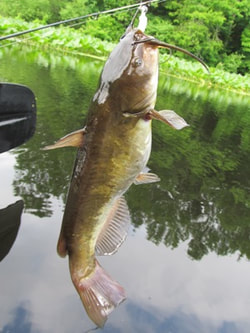Many of the fish that are caught in lakes in Wayne and Pike county are surprisingly invasive species in the Delaware River watershed which can be seen below. Common sport fish that are invasive are Smallmouth Bass, Largemouth Bass, Northern Pike, Muskellunge, Rock Bass, Crappies, Walleye, and Bluegills. Commonly known species that are native to this area include the Pumpkinseed sunfish, Redbreasted sunfish, yellow perch, and Bullhead catfish.
Many of these fish are also stocked for sport fishing. Lake Wallenpaupack, for example, is regularly stocked with trout, bass, and walleyes. Below, you can see a map identifying all fish habitats found in Lake Wallenpaupack, both of the stocked and native fish.
All these fish species follow the same life cycle. They begin spawning in the springtime, when fish will begin to lay their eggs. These eggs hatch into smaller larvae that feed off of a yolk sac they develop, and when the yolk is fully absorbed, the fish move onto the fry stage. Fry's can eat their own food, and will remain this size for varying times, depending on species, but most will average around a few months to less than a year. As fish mature, they become juveniles. Juveniles are not quite to the same maturity as adults, and many do not survive to reach full maturity. Various factors can influence the lifespan of a fish, including predators and climate change. The few who do make it to maturity however, live on to continue the cycle and spawn the next generation of fish.
All these fish species follow the same life cycle. They begin spawning in the springtime, when fish will begin to lay their eggs. These eggs hatch into smaller larvae that feed off of a yolk sac they develop, and when the yolk is fully absorbed, the fish move onto the fry stage. Fry's can eat their own food, and will remain this size for varying times, depending on species, but most will average around a few months to less than a year. As fish mature, they become juveniles. Juveniles are not quite to the same maturity as adults, and many do not survive to reach full maturity. Various factors can influence the lifespan of a fish, including predators and climate change. The few who do make it to maturity however, live on to continue the cycle and spawn the next generation of fish.
A Pocono Comparative Lakes Program Report was conducted in 1990 to study the trophic levels of several lakes in the Pocono region, as well as the different species of fish that could be found in three different lakes. Lake Lacawac was even included in this study! The other lakes included in the study were Lake Giles and Lake Waynewood. The study found that each lake had different levels of fish diversity, with Lacawac being the most diverse of the three. In Lake Lacawac itself, the moat common predatory species were small and large-mouth bass and chain pickerel. The most common prey species found were bluegills, pumpkinseeds, yellow perches, and golden shiners. Each lake also varied in eutrophication, which is the amount of minerals and nutrients found in the water. Lake Lacawac was semi eutrophic, with the species of fish found coinciding well with the trophic level. The most common species found together were the chain pickerel, yellow perch, and brown bullhead catfish.
In June of 2021, several researchers from the Miami University in Ohio and one from Rensselaer Polytechnic Institute (RPI) gave a presentation on how to help identify any fish you might have found. The researchers were Nikki Berry, Isaac Smith, and Addie Zeisler, all from Miami University, and Jonathan Stetler from RPI. In their presentation, they highlighted some key features found on fish that can help you identify the species, as well as resources that can provide you with more information than they have given. Check out some of their presentation slides below and see if you can identify fish on your own!
Location |
|






